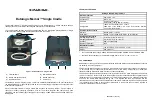
23
6
Strong breeze
39 ~ 49 km/h
Large branches in motion. Whistling heard
in overhead wires. Umbrella use becomes
difficult. Empty plastic bins tip over.
25 ~ 30 mph
22 ~ 27 knots
10.8 ~ 13.8 m/s
7
High wind
50 ~ 61 km/h
Whole trees in motion. Effort needed to
walk against the wind.
31 ~ 38 mph
28 ~ 33 knots
13.9 ~ 17.1 m/s
8
Gale
62 ~ 74 km/h
Some twigs broken from trees.
Cars veer on road. Progress on foot is
seriously impeded
39 ~ 46 mph
34 ~ 40 knots
17.2 ~ 20.7 m/s
9
Strong gale
75 ~ 88 km/h
Some branches break off trees, and some
small trees blow over. Construction /
temporary signs and barricades blow over.
47 ~ 54 mph
41 ~ 47 knots
20.8 ~ 24.4 m/s
10
Storm
89 ~ 102 km/h
Trees are broken off or uprooted,
structural damage likely.
55 ~ 63 mph
48 ~ 55 knots
24.5 ~ 28.4 m/s
11
Violent storm
103 ~ 117 km/h
Widespread vegetation and structural
damage likely.
64 ~ 73 mph
56 ~ 63 knots
28.5 ~ 32.6 m/s
12
Hurricane force
≥ 118 km/h
Severe widespread damage to vegetation
and structures. Debris and unsecured
objects are hurled about.
≥ 74 mph
≥ 64 knots
≥ 32.7m/s
4.3.9 BAROMETRIC PRESSURE
The atmospheric pressure is the pressure at any location of
the earth caused by the weight of the column of air above it.
One atmospheric pressure refers to the average pressure and
gradually decreases as altitude increases. Meteorologists use
barometers to measure atmospheric pressure. Because absolute
atmospheric pressure decreases with altitude, meteorologist
correct the pressure relative to sea-level conditions. Hence, your
ABS pressure may read 1000 hPa at altitude of 300m, but the
REL pressure is 1013 hPa.
To obtain accurate REL pressure for your area, consult your local
official observatory or check weather website on Internet for real
time barometer conditions, and then adjust the relative pressure
in SETUP (section 6.4.1)
4.3.9.1 ABSOLUTE OR RELATIVE BAROMETRIC PRESSURE MODE
In normal mode, press
[ BARO ]
key to switch between ABSOLUTE and RELATIVE barometric
pressure.
















































